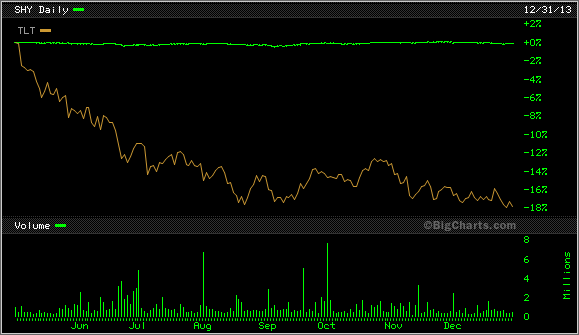Interest Rates and Bond Prices
Markets are highly complex and interest rates do not always affect investments the way pundits speculate they will. However, with bond prices, the effect of interest rate changes is in fact both direct and mathematically calculable.To get a bond’s current yield, divide the interest it pays by its current price. If the price goes up, the yield goes down. If the price goes down, the yield goes up. Thus, in order for the yield to go up the price must go down. When you read that rates on bonds have risen, it means their prices have fallen.
Higher yields mean higher risk, no exceptions. Anything paying high interest should be considered suspect, not enticing.
In the spring of 2013, when interest rates did finally rise a little, we felt compelled to write “Interest Rates Up, Bonds Down. Now What?” about which bonds were exposed to greater risk and how we manage the risks. We did not believe the potential for rates to rise was a cause for concern because we favor shorter term bonds which are less susceptible to interest rate changes. Long term bonds are much riskier, we explained.
As 2013 came to a close, the Federal Reserve had not raised the target rates it controls, yet yields on longer term issues rose anyway. The 30-year treasury was yielding 3.98%, up from a low of 2.81% in May. Figure A illustrates our point. It contrasts the changes in the market value of an exchange traded fund that holds only U.S. treasury securities with maturities of three years or less (green line) with the changes in the market value of an exchange traded fund that holds only U.S. treasury securities with maturities of 20 years or more (orange line) from May 1 to December 31, 2013.

Given that the primary reason to hold bonds is for stability, it is easy to see why we favor shorter maturities. We may not get a high rate of interest from shorter term holdings but we will protect assets from significant losses – a classic risk/reward trade off. The difference in volatility is striking. An 18% decline in value in just a few months is what we would expect periodically from the stock market. Such large losses are avoidable as long as we do not seek substantially higher yields than is available in the market.
Higher yields mean higher risk, no exceptions. Anything paying high interest should be considered suspect, not enticing.
Interest Rates and Stock Prices
While the relationship between interest rates and bonds is clear, direct, and predictable, the connection between interest rates and stock prices is decidedly unreliable.
Theoretically, if interest rates go up, stock prices would go down. Corporations would have higher costs to borrow which would cut into profits. With bonds yielding more, some people would be motivated to move money from stocks to bonds and would accept lower prices to make the switch. That’s the theory. The reality? No one knows what will happen but the historic record simply does not support the theory. As we are quick to point out, markets are unpredictable because there are so many other variables which come into play.
We have seen a steady stream of studies looking at stock market performance during prior periods of rising rates and the conclusion is interest rates do not affect stock performance as neatly as the theories suggest. For instance, a UBS study looked at the last six times the Fed raised the federal funds rate after two good years for stocks. Only in 1994 did stocks (as represented by the S&P 500 index) retreat when they declined 1.5% from the time the Fed started to raise rates in February through the end of that year. In the other five instances, the weakest advance was 11.3% over nine months in 1999 and the strongest came after rate increases in 1988 that logged a 41.9% advance over 28 months.

Also of note was that his study supports our contention that broad diversification is the best approach to navigating chaotic and volatile markets. The difference in the performance of the bond indexes in the rising rate period versus the falling rate period was significant, 3.83% vs. 8.82%. However, by diversifying, the effect of the rate changes was reduced. A simple switch to an annually rebalanced mix of 60% stocks and 40% bonds raised the returns. This makes sense since we would expect stocks to beat bonds over long periods of time. The difference between the 60/40 mix in the rising rate period and the 60/40 mix in the falling rate period was less dramatic than the all bond scenarios, 8.52% vs. 10.56%. When Israelson replaced some of the large company stocks with small company stocks and used cash in place of some bonds, the difference in results shrunk even more, 9.52% vs. 9.99%.
As Israelson put it, “By design, a diversified investment portfolio is insulated – not completely, but largely – from the normal swings in performance among its various components. The underperformance of one or several of its ingredients will not sink the performance of the overall portfolio. In fact, a strategically built, diversified portfolio will always include asset classes that have underperformed within a time frame. This is unavoidable. But it’s the overall performance of the entire portfolio that matters. We can’t predict with accuracy the future returns of various asset classes, but based on the past it is clear that building diversified portfolios liberates us from needing to make such predictions.”
Contact Us
If you have any questions or would like to discuss this further, please give us a call or send us a note.
To receive emails notifying you of new posts – no more than monthly – fill out the subscription information in the sidebar to the right.
